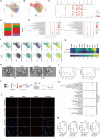Inhibition of Interleukin-40 prevents multi-organ damage during sepsis by blocking NETosis
- PMID: 39819454
- PMCID: PMC11740647
- DOI: 10.1186/s13054-025-05257-2
Inhibition of Interleukin-40 prevents multi-organ damage during sepsis by blocking NETosis
Abstract
Despite intensive clinical and scientific efforts, the mortality rate of sepsis remains high due to the lack of precise biomarkers for patient stratification and therapeutic guidance. Interleukin 40 (IL-40), a novel cytokine with immune regulatory functions in human diseases, was elevated at admission in two independent cohorts of patients with sepsis. High levels of secreted IL-40 in septic patients were positively correlated with PCT, CRP, lactate (LDH), and Sequential Organ Failure Assessment (SOFA) scores, in which IL-40 levels were used to stratify the early death of critically ill patients with sepsis. Moreover, genetic knockout of IL-40 (IL-40-/-) improved outcomes in mice with experimental sepsis, as evidenced by attenuated cytokine storm, multiple-organ failure, and early mortality, compared with those of wild-type (WT) mice. Mechanistically, single-cell RNA sequencing (scRNA-seq) and bulk RNA sequencing (RNA-seq) have revealed that S100A8/9hi neutrophil influx into the peritoneal cavity along with neutrophil extracellular trap (NETs) formation accounts predominantly for the IL-40-mediated worsening of sepsis outcomes. Clinically, the IL-40 level was positively correlated with the NET-related MPO/dsDNA ratio in septic patients. Finally, with antibiotics (gentamycin), genetic knockout of IL-40 prevented polymicrobial sepsis fatalities more efficiently than without gentamycin treatment. In summary, these data reveal a novel prognostic strategy for sepsis and that IL-40 may serve as a novel therapeutic target for sepsis.
Keywords: IL-40; NETs; Prognostic; Sepsis; Theranostic.
© 2025. The Author(s).
Conflict of interest statement
Declarations. Ethics approval and consent to participate: The human study was approved by the affiliated Zhongda Hospital of Southeast University Clinical Research Ethics Committee (Registration No. 2023ZDSYLL463-P01), and written informed consent was obtained from patients or their legally authorized representatives before enrollment, according to the Declaration of Helsinki. All animal experiments complied with the guidelines of the Animal Experimentation Ethics Committee (AEEC) Guide for the Care and Use of Laboratory Animals and were approved by the AEEC, Southeast University. Competing interests: The authors declare no competing interests.
Figures






References
-
- van der Poll T, Shankar-Hari M, Wiersinga WJ. The immunology of sepsis. Immunity. 2021;11:2450–64. - PubMed
MeSH terms
Substances
Grants and funding
- 82302609/National Natural Science Foundation of China
- 82373781/National Natural Science Foundation of China
- BK20230840/the Basic Research Program of Jiangsu Province
- 3290002409A2/the Tang Scholar supporting grant
- CZXM-GSP-RC97/the Research Personnel Cultivation Program of Zhongda Hospital, Southeast University CZXM-GSP-RC97
LinkOut - more resources
Full Text Sources
Medical
Research Materials
Miscellaneous

